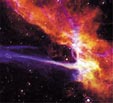An observation of an exploding star last December left scientists with many question marks

3.9.2003
By: Dr. Noah Brosh
Supernovae - the process that ends in the explosion of stars - have become a very "hot" research topic in astrophysics in recent years. An observation of a certain supernova last December left scientists with some question marks about this mysterious and intriguing process.
Before a supernova explosion, within a few days there is an incredible increase in the brightness of the star, which reaches at the peak of the process the brightness of an entire galaxy. The researchers wondered how it was possible for a relatively small body to reach the brightness of trillions of stars so quickly. Today it is believed that understanding the formation of the supernova is necessary for understanding
The accelerated expansion of the universe.
In principle, the astronomers believed, there are two types of supernovae. In the first type, the process takes place in a star 8 times larger than our Sun. During thermonuclear combustion, the hydrogen in the star's core turns into helium; Helium - to carbon; the carbon –
to silicon and heavier elements, until the core of the star collapses and a tiny mass is formed with a mass many times greater than that of the Sun. The final result: a neutron star or a black hole - a compact body, with a huge gravitational force and the ability to throw off its layers
The supremacy at enormous speed and while emitting a tremendous amount of light.
The second type of supernova occurs when a star as small as the Earth, with a quantity
Matter like in the sun, adsorbs mass from a partner. When the mass of the star increases to 1.4 times the mass of the Sun - it collapses. Then a neutron star is formed, except that in this case, a lot of radiation is emitted and uniform in its amount. An example of this is the supernova known as Ia. If measured
Its brightness, the distance between it and the Earth can be calculated. Ia supernovae do not contain hydrogen, because they originate from a star that has finished its nuclear combustion process.
The new discovery on this subject refers to the supernova seen in December 2002. It was also of type Ia, but surprisingly, the spectroscopic observations showed that there were very large amounts of hydrogen near the star that exploded. The explanation given now (as a hypothesis) for the explosion: it may not be a relatively small star that collapsed and turned
to a neutron star, but rather in a star 25 times larger than our sun - which exploded.
Despite the interesting result, it is still too early to eulogize the studies that showed that the universe is expanding in an accelerated manner, based on measuring distances from type Ia supernovae.
